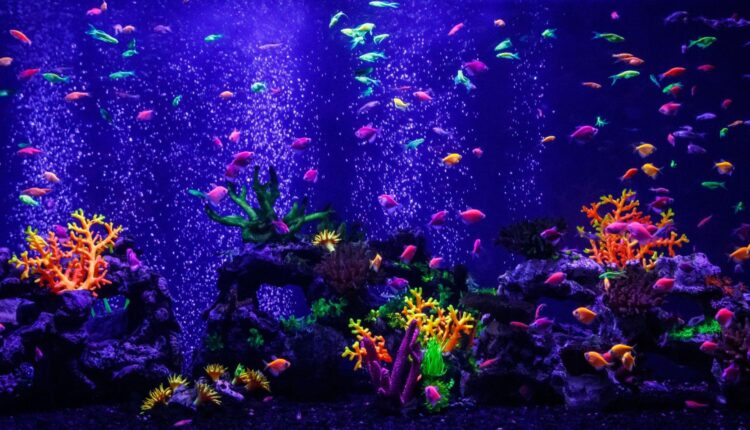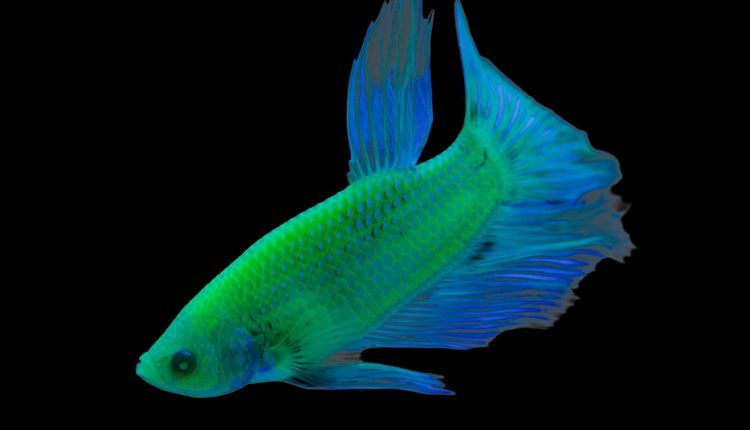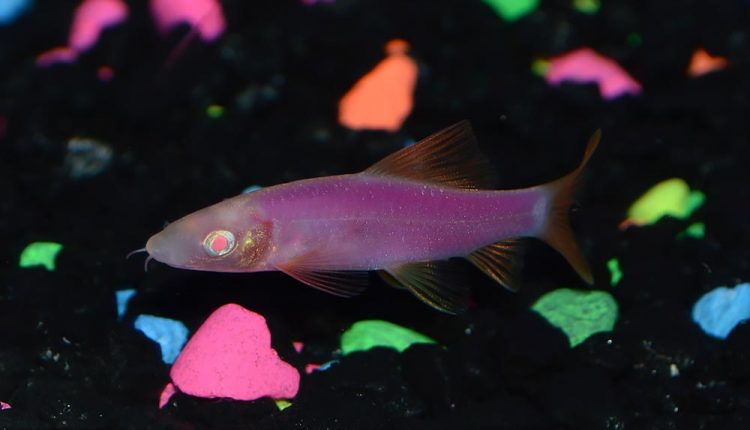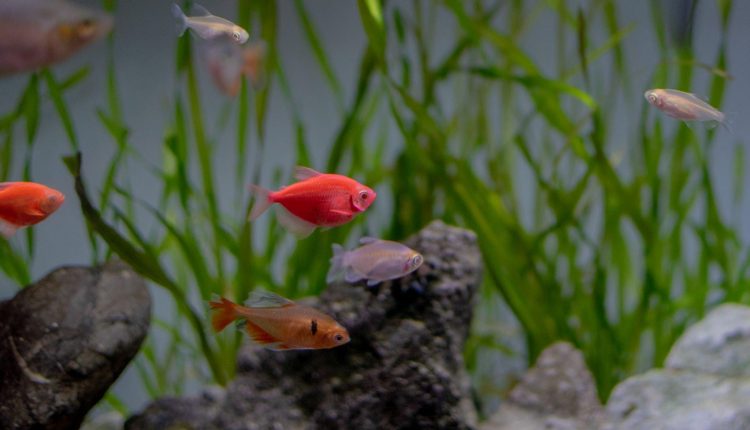How to Breed Glofish: the Complete Guide

Glofish are one of the most spectacular additions to the aquarium. hobby in recent years. They have intense colors that even saltwater fish struggle to match. And they are much hardier and way more affordable. So naturally, you might be wondering how to breed glofish!
Glofish breeding is easy, for the most part. There are some differences since there are really five different species of glofish. So long as the breeding pair are both glofish, the babies will also glow under natural ultraviolet lighting.
The breeding process is educational and fun for aquarists of all ages. It just takes some patience and a willingness to learn!
What are Glofish?
Glofish are the first genetically modified fish to be sold as pets. The very first was the zebra danio. These fish are the natural starting place because zebrafish are a model organism for scientists.
A model organism is a species that is well studied and easy to care for in laboratory settings. It also has characteristics that can be applied across species. Laboratory mice and rats are the most famous example! But zebra danios have also taught is a lot in the lab.
One of the most successful discoveries was that transferring genes between distantly related species is possible. The glow of a glofish comes from jellyfish DNA that expresses unique proteins. These molecules fluoresce when exposed to natural white light and ultraviolet light.
The first glofish danios were bright green. But the researchers found that they could also produce pink, purple, yellow, and orange fluorescence as well. And before long, the process was extended to other common aquarium fish, starting the glofish trend!
This video does an excellent job of breaking down what glofish and other manmade breeds of fish really are:
Is Keeping Glofish Moral?
Detractors may call glofish unnatural, or the process to create them cruel. But it’s worth mentioning that humans have been genetically modifying organisms for thousands of years.
Farm vegetables, domestic dog breeds, cat breeds, chicken varieties…All of them are genetically modified from their wild ancestors. Genetic tinkering in the lab merely speeds up the process. Plus it allows us to do formerly impossible things like swap genes between species!
The process is also entirely painless as its the embryonic fish that are modified, not adults. Glofish also breed true and pass down the genes for fluorescence to their babies.
There are no known side-effects from the insertion of jellyfish and coral DNA. Glofish are just as hardy as non-modified fish and live alongside them with no issues. The change is, quite literally, skin-deep.
And there is little risk of escaped glofish spreading modified genes to wild fish. Were they released into the wild, they would quickly be eaten. The bright colors of glofish make them instant marks for any predators around.
Glofish Species
Breeding glofish is a little more complicated than you might expect. Because there is more than one singular glofish species. There are five species of fish that have the glofish genes. And all of them have somewhat different care requirements.
Glofish Danios
Glodanios were the very first glofish species to enter the aquarium trade. They are just as hardy and easy to keep as the original zebra danio. All danios prefer water chemistry as close to neutral as possible (pH 6.5-7.5).
Danios are a cyprinid fish breed. Making them close relatives of goldfish, koi, barbs, and rasboras. Zebrafish are cold hardy enough to live even in unheated cold water tanks.
They prefer a temperature range of 65-74°F, with the higher end simulating the spring and summer spawning season.
Zebrafish are omnivorous but don’t eat aquarium plants. Algae and small invertebrates are their favored source of food. But they eat flakes with gusto! Peaceful and active, glodanios are the perfect addition to community tanks of small aquarium fish.
- Scientific Name: Danio rerio
- Origin: South Asia
- Length: 2 inches
- Aquarium Size: 10 gallons
Temperament: Peaceful; Schooling
Glofish Tetra
Glofish tetras were created using the black skirt tetra, a South American native. Unlike most tetra fish, black skirt tetras have a chunky body more like a barb than a neon tetra.
Black skirt tetras are mostly peaceful. But they are known to nip at slow-moving tank mates with long fins. Globettas are a favorite target of theirs. As well as angelfish, swordtails, and fancy guppies.
So keep them only with similarly sized fish with short fins. Otherwise glofish tetra fish are hardy and long-lived, reaching up to 5 years in age.
Trying to breed glofish tetras is not as easy as glodanios. Tetra fish prefer soft, acidic water parameters and no trace of ammonia or nitrite.
Tetra fish are also carnivores and love insect larvae, worms, daphnia, and other small animals. The more of them you feed, the easier it will be to breed glofish tetras.
- Scientific Name: Gymnocorymbus ternetzi
- Origin: Paraguay River Basin, South America
- Length: 2 to 3 inches
- Aquarium Size: 20 gallons
- Temperament: Peaceful; Schooling
Glofish Barb
The glofish barb is genetically engineered from another aquarium favorite: the tiger barb. Tiger barbs have been in the hobby for decades and already come in albino, green, cherry, and gold morphs.
But globarbs are something entirely new and also come in a long-finned variety. Tiger barbs are similar in care requirements to glofish tetras. They are also known to be fin nippers.
That said, gloish barbs are easier to spawn. They also don’t require as much carnivorous food. Barbs are omnivores, feeding on plant and animal matter alike.
Pieces of boiled lettuce or zucchini will help condition them. As well as generous helpings of brine shrimp and bloodworms!
- Scientific Name: Puntigrus tetrazona
- Origin: Southeast Asia & Indonesia
- Length: 5 inches
- Aquarium Size: 20 gallons
Temperament: Semi-aggressive; Schooling
Glofish bettas
Glofish bettas are the newest glofish found in pet stores. Betta fish have already been bred for bright colors for many centuries by Thais. Yet modern genetic engineering offers us a new look at the popular Siamese fighting fish!
Not only are globettas just as hardy as a non-modified fish. The male and female fish are both brightly colored. Normally, female betta fish are smaller and have duller colors.
Betta fish are the only species on this list that do well living alone. A common myth is that they are too aggressive to live with any other fish. But the truth is that only the males are aggressive. Plus, you should never keep males with other males.
Male glofish bettas will thrive in a community tank with other fish. They may act aggressively at times. But they save the worst of their anger for each other.
- Scientific Name: Betta splendens
- Origin: Thailand
- Length: 3 inches
- Aquarium Size: 5+ gallons
- Temperament: Semi-aggressive
Glofish Sharks
Glofish sharks are one of the most recent additions to the glofish species you can choose from. The original fish is often sold as rainbow sharks. Their natural color is a dull grey to purple, with bright red fins.
The glofish rainbow shark is the largest species available so far. They reach up to 6 inches long.
They are also one of the least social glofish species as these fish are territorial towards their own kind. As well as other fish that try to invade their favorite hiding places.
That said, they do well in mixed community tanks with other medium sized, semi-aggressive fish. Globettas, glofish barbs, and glofish tetras do best with them. Fish that don’t live near the bottom are the best tank mate choices.
- Scientific Name: Epalzeorhynchos frenatum
- Origin: Southeast Asia
- Length: 4 to 6 inches
- Aquarium Size: 30 gallons
Temperament: Semi-aggressive
Can Glofish Mate with Non-Genetically Modified Fish?
Glofish will mate with both their own kind of glofish. As well as non-glofish tetras, danios, sharks, bettas, or barbs. If you want the babies to be glofish then you need to pair a glofish male and female fish.
Breeding glofish with non-glofish gives you a 50% chance of the babies being glofish or not. However, they are not sterile and will create healthy babies, unlike other genetically modified fish.
Breeding glofish with non-glofish is easy to do since the fish species have the same mating behaviors as an unmodified fish. Non-glofish treat them like others of their own kind. Glofish can also live together with non-glofish, even if you aren’t looking to breed them!
Is it Illegal to Breed Glofish?
It’s technically illegal to breed glofish – but only for selling or trading. Glofish are a patented genetically modified fish owned by Spectrum Brands, Inc.
This means that only licensed distributors can supply them to hobbyists. That said, if you want to breed glofish for the fun of it or as a learning experience, there are no prohibitions!
Glofish may also be illegal in your country. Especially if the climate is moderate enough for escaped fish to survive. So check your local laws before deciding to buy and breed glofish.
How to Breed Glofish
Breeding glofish is simple for bettas, tetras, barbs, and danios. Breeding glofish sharks is more difficult since these fish are so territorial.
Setting Up a Glofish Breeding Tank
I recommend setting up a separate breeding tank whenever possible. Non-breeding glofish in the tank will quickly eat any eggs laid by the parent fish. If you want to raise the fry then you need some method of separating them.
All a glofish breeding tank needs is water that’s been fully cycled, a simple filter, and a place for the fish to lay their eggs. Live and plastic plants are the most common choices for the breeding process!
Live and Plastic Plants
There are two main types of glofish breeding behavior to plan for. The first is egg scattering, where the parent fish provide no care. And the second is where they do protect their eggs.
Egg scatterers simply lay eggs in a hidden place and allow the fish fry to fend for themselves. Many will forget they spawned and may eat their eggs or fry after breeding.
Glofish tetras, glofish danios, glofish barbs, or glofish sharks are all egg scatterers. So you need submerged plants for them to attach their eggs.
You can use live plants if you want. Live plants have a number of benefits; they consume ammonia, nitrite, and nitrate as fertilizer. They provide shade and a sense of security for shy fish species.
Plants also consume carbon dioxide, releasing it as oxygen through photosynthesis. Plants do need light of the right spectrum and an appropriate water temperature.
If live plants sound like too much fuss then plastic plants work just as well. As do plastic or yarn breeding mops. They are not temperamental like live plants sometimes are. Plus they can be stored indefinitely when not needed for breeding tanks.
Filter Options
If you can isolate your glofish to a breeding pair then a simple filter is more than enough. Sponge filters are great for quarantine and breeding tank setups. You should have the tank up and running well before your fish are ready to spawn, however.
A well-cycled breeding tank means that you have beneficial bacteria already established. These bacteria break down the ammonia fish release as waste. Without it, your new fish are likely to die from ammonia toxicity.
Another benefit of a sponge filter is its low flow rate. Power filters are so strong that they can suck up any unattached eggs or free swimming fry. Sponge filters won’t cause harm to the babies you want to raise after the parents are finished with egg laying.
Pair your sponge filter with an airstone and air pump. Water circulation needs to be gentle in a breeding tank. But oxygenation is still important. Still, stagnant water will also breed bacteria and fungi. Which can cause fish eggs to go bad before they have a chance to hatch.
Water Conditions for Breeding Glofish
Every glofish on our list prefers neutral to slightly acidic water conditions (pH 5.5-7.0). Glofish danio breeding is most likely to succeed if you can keep the pH neutral (ph 7.0). All glofish do well even in alkaline conditions but spawning is a different story.
The water temperature should also be elevated. Fish are ectothermic animals, meaning they get their body heat from the environment. Unlike us endotherms, that are warm even when it’s cold out.
A warm water temperature ensures that glofish can metabolize extra food into eggs and sperm. It also mimics seasonal cues, further stimulating them to spawn.
Aim for temperatures of 78-84°F when trying to breed glofish. Except for glodanios, which prefer cooler temperatures around 72-74°F.
Conditioning Glofish to Spawn
Anyone studying how to breed glofish needs to provide not only warm and clean water parameters. But also a constant supply of rich and nutritious food items!
Food flakes are okay for a basic glofish diet. But you aren’t likely to breed glofish with them. Instead, we need to offer frozen and live food.
Brine shrimp, blood worms, tubifex worms…These foods are rich in fat and protein that fish need for egg and sperm production.
It does not matter whether these items are live or frozen; both are great in terms of nutrition. Freeze-dried foods are the most convenient but you do lose some nutrients by dehydrating them.
I recommend feeding your glofish these treats at least a few times per week. It’s very important to diversify their diet to stimulate spawning behavior. Feeding rich foods to breed animals is called “conditioning” your pets!
Breeding Glofish Bettas
Bettas, unlike other glofish species, provide parental care for their babies. The male builds a bubble nest among floating plants if there are any. Or he will choose a quiet corner of your aquarium at the surface.
He entices the female beneath it and places the fertilized eggs inside. The male then guards the eggs and newly hatched fry until they are large enough to fend for themselves.
A breeding pair can be hard to find because males are so very aggressive. A female betta needs to be not only a healthy fish. But also ready for egg laying. If not, the male may kill her, especially if the aquarium is too small for her to hide.
You’re better off keeping multiple female glofish for every one male. That way he won’t be able to bully any one female too often.
If you want to keep just one female then condition her in a separate aquarium first. A rich diet of live and frozen food will help her swell up, signaling that she is ready for laying eggs. Only then introduce her to the male.
Betta fish nests are very fragile. Therefore, you should use the main tank as the breeding tank. If you try to move them after spawning the nest will likely fall apart and the male will abandon it.
Breed Glofish Sharks
Most glofish species are easy to spawn but glofish sharks are not one of them. These fish are too territorial; in the wild, they live alone their entire lives except during the breeding season.
Shredded fins are a common sight in a tank full of glofish sharks. They will even bite at the eyes of their rivals! Only keep a single glofish shark per aquarium.
Fish farms use giant ponds where fish can flee from aggressive neighbors if they are not ready to lay eggs. Farms also use hormone treatments to encourage their fish species to spawn on demand.
Unless you have a giant pond in a tropical area of the world, you aren’t likely to breed glofish sharks.
Raising Glofish Fry
Once your glofish tetras, barbs, sharks, or danios have spawned, you need to act quickly after the egg laying occurs. Remove any live plants, artificial plants, or spawning mops with eggs attached to them.
Glofish eggs are usually a pale yellow color. They are small and hard to see, so look carefully. Most fish lay eggs in the early morning, where the low light levels keep predators from easily catching them.
You will notice that the female glofish will be less bloated since she is no longer having to carry eggs. The males will also be less interested in her and stop chasing her all over the tank.
The eggs should be moved to a fry-rearing aquarium, where they will hatch in a few days to a week, depending on the species.
Feeding Glofish Fry
Glofish fry are too small to eat frozen flakes or dried fish flakes. You need to use appropriately sized live, frozen, or prepared food. And you should have it on hand as soon as they hatch.
Baby fish don’t eat the first 1 to 2 days after hatching. They survive off of their yolk sack, which has all of the nutrients they need. But after that, they need to eat all of the time. And even a day of no food can be fatal to them.
Start with baby brine shrimp (nauplii), which are easy to find in most pet stores. If you can’t find them live, you can try frozen nauplii. But baby fish are often primed to hunt for movement. They may not realize they can eat dead foods and starve.
Fortunately, brine shrimp are easy to raise on demand for baby fish! You can also grow infusoria, which is a culture of microorganisms like amoeba and paramecium.
Globetta fry are too tiny to eat even brine shrimp nauplii when they first hatch. They need infusoria soup for the first week of their lives before switching to larger prey.
Conclusion
Learning how to breed glofish is an excellent way to advance your knowledge as an aquarist. You get to appreciate the entire life cycle of your pets. The challenge level varies from easy to very difficult. But it’s well worth the attempt!
There will be more glofish species as time goes on. But this care guide will remain relevant for any of them. The tips here cover all of the basics for providing proper water chemistry, food, and tank layouts for breeding!
Just make sure that you don’t sell glofish to friends or local pet stores. They remain patented genetically modified organisms, making that illegal to do.







